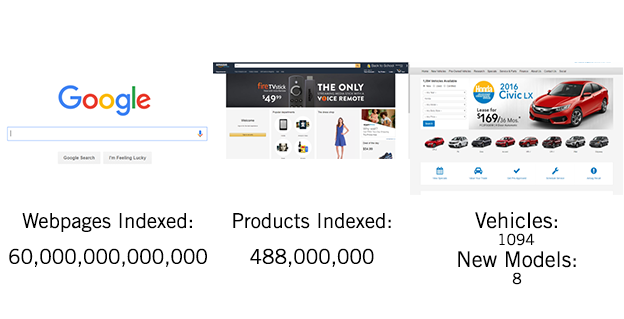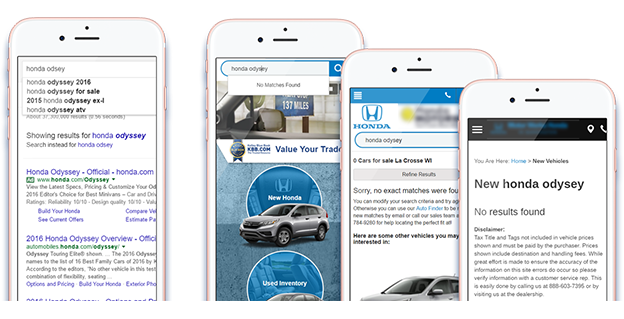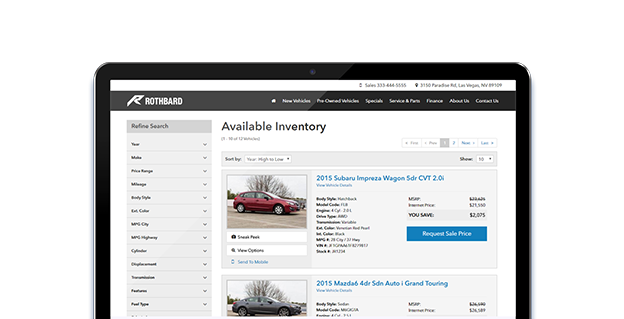

Let’s be upfront about this: I advocate filtered site search as opposed to free form search, and here’s why.
When it comes to finding things on your website, your customers are either clicking buttons or using a search box. This is true whether you sell cars, cookies, or clothes. Nearly every single person on your website looking for a particular vehicle will either click on the “New” or “Used” buttons that you (hopefully) have in your navigation bar, or they’re mousing over to the search box and manually typing it in.
And therein lies the problem, at least a potential one. What do you do when someone misspells a search term, or perhaps mixes & matches the brand/model of a car? Is it easier to let customers search your site on their own, hoping there are no spelling errors? Or should you offer pre-filtered results, to better guide their search?
For a giant like Amazon.com, free form site search is no problem. You can search for “top gnu blu-ray” and Amazon will immediately show you the Tom Cruise classic, and not a weird documentary on South African wildlife. Cool, right? Amazon’s search function is smart enough to predict typos and guess the searcher’s intent – and it’s usually right!
But all websites are not created equal, sadly, and the typical car dealership doesn’t have that kind of site search functionality. But, that’s okay, because your typical car dealership isn’t indexing millions of webpages or items in inventory, either. Amazon might do that, but odds are that your dealership doesn’t.

And while it’s very difficult to get the dreaded “0 results match your search” message through Amazon, it’s quite easy to get it on a car dealer’s website using free form search. Again, a massive website with millions of pages will have the capacity to pre-filter spelling errors and close matches, but not a dealership website with well under 1,000 pages. Someone searching for “2017 toyota sequoia” might type “seqioah” or “seqoiah” and it’s the same story with models like the Honda Odyssey, the Hyundai Tucson, and many others.
If your customers are looking for a specific car, and many of them are, then why risk showing them a “0 results” page that they know is incorrect?

In the picture above, you can see that a Honda dealership is telling this person that they don’t have a Honda “Odysey” in stock. True, but I’m betting they have lots of Honda Odysseys on their lot. That kind of snafu will only frustrate customers and potentially cause them to bounce off your site. A frustration-free experience is what we’re all after, and you can expect customers to spend less time on your site if they can’t even search for their car.
This problem can become even more exaggerated when people start modifying their searches to include things like leather seats, specific trim levels, audio add-ons, and more. Sure, you might not have a 2017 Ford F-150 with Pioneer speakers, but you DO have a 2017 Ford F-150 with a Bose speaker system. See what I mean? If your website is using free form search, customers can get discouraged because they end up seeing what you don’t have, rather than what you do have.
At the end of the day, that’s the strategic reasoning behind using a filtered search function. By letting customers select all 2017 vehicles, then all Hondas, then all Odysseys (and so on), they can quickly find what they’re looking for – or something close to it.

Think of free form search like walking into a Barnes & Noble, but with no bookshelves or categories. If you had to find your favorite book by typing the title into a computer exactly as it appeared on the cover, let’s just say I’m not betting on that outcome. A filtered search approach would be looking at the appropriate aisle or shelf, and then scanning through the titles alphabetically.
Let’s also put this into a bigger context: your overall website strategy. It’s no secret that we’re living in a mobile-first world. I’ve talked about mobile design before, as well as the importance of a responsive and adaptive website. Google told us that over half of car shoppers are using their phones for research, and that was in 2015. It’s only gone up since then.
A mobile-first strategy means that your website is optimized for mobile users. Does free form site search fit with a mobile-first strategy? Well, how many times does AutoCorrect save you from embarrassment when sending text messages? If you’re like me, a lot, and your customers are probably no better at typing with their thumbs. Furthermore, consider that voice search with programs like Siri, Google Assistant, Cortana, and Alexa are also becoming more ubiquitous. Now, I love voice search and voice-to-text as much as the next guy, but do you really want to trust Siri with that kind of responsibility? It’s much easier to let your customers simply tap through a list of options and find exactly what you’ve got on the lot.


